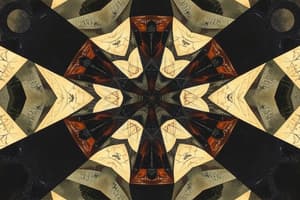Podcast
Questions and Answers
What is the most basic geometric shape?
What is the most basic geometric shape?
- Planes
- Lines
- Points (correct)
- Triangles
Which geometric shape is defined as a set of points equidistant from a center point?
Which geometric shape is defined as a set of points equidistant from a center point?
- Lines
- Ellipses
- Triangles
- Circles (correct)
What type of polygon has four sides and four angles?
What type of polygon has four sides and four angles?
- Parallelograms
- Squares (correct)
- Rectangles
- Circles
Which geometric property refers to the ability of a figure to be rotated around a point and still look the same?
Which geometric property refers to the ability of a figure to be rotated around a point and still look the same?
What is a flat, two-dimensional surface that extends infinitely in all directions?
What is a flat, two-dimensional surface that extends infinitely in all directions?
Which geometric shape consists of three sides and three angles?
Which geometric shape consists of three sides and three angles?
What is a polygon?
What is a polygon?
How is the sum of interior angles calculated for an n-sided polygon?
How is the sum of interior angles calculated for an n-sided polygon?
What is the formula for calculating the area of a polygon?
What is the formula for calculating the area of a polygon?
What does symmetry refer to in geometry?
What does symmetry refer to in geometry?
What type of symmetry involves reflecting a figure across a line?
What type of symmetry involves reflecting a figure across a line?
How are polygons classified according to their number of sides?
How are polygons classified according to their number of sides?
Flashcards are hidden until you start studying
Study Notes
Geometry: Exploring Polygons, Symmetry, and Shapes
Geometry, a cornerstone of mathematics, is a discipline that deals with spatial properties and relationships. In this exploration, we'll delve into the fascinating world of polygons, symmetry, and diverse geometric shapes.
Polygons
A polygon is a flat shape with a finite number of sides and interior angles. Each side (edge) is connected to exactly two other sides, and each interior angle is formed where two sides meet at a vertex (corner). Polygons are classified according to their number of sides, such as a triangle (3 sides), square (4 sides), pentagon (5 sides), and so on.
Polygon properties:
- Sum of interior angles: For an (n)-sided polygon, the sum of its interior angles is ((n-2) \times 180) degrees.
- Area: The area of a polygon can be calculated using the formula (A = \frac{1}{2} \times \text{perimeter} \times \text{semi-perimeter}) or using more advanced formulas specific to various polygon types.
Symmetry
Symmetry is the property where an object appears the same when divided into two or more equal parts. In geometry, we focus on spatial symmetry, which considers the reflection of shapes across lines and rotations around points.
Types of symmetry:
- Line of reflection (mirror symmetry): When a figure is symmetric with respect to a line, it means that the line divides the figure into two identical halves.
- Rotational symmetry: When a figure is symmetric with respect to a point, it means that the figure can be rotated about the point by a specific angle and still appear the same.
Geometric Shapes
Geometric shapes come in all sizes and configurations, and understanding their properties is crucial to grasping the fundamental concepts of geometry. Here are some common shapes:
-
Points: The most basic geometric shape, a point is a location without size.
-
Lines: An unending one-dimensional path with no thickness.
-
Planes: A flat, two-dimensional surface that extends infinitely in all directions.
-
Triangles: A polygon with three sides and three angles.
-
Quadrilaterals: A polygon with four sides and four angles. Examples include squares, rectangles, and parallelograms, each with specific properties.
-
Circles: A set of points in a plane equidistant from a given point, called the center.
-
Ellipses: A set of points in a plane the sum of whose distances to two fixed points (foci) is constant.
Geometry is a fascinating subject rich with hidden patterns and deep connections. By exploring polygons, symmetry, and geometric shapes, we've only scratched the surface of the vast world of geometry and its applications. Whether you're studying it for a class, working on a project, or simply curious to know more, the exploration of geometry and its wonders is sure to leave you captivated.
Studying That Suits You
Use AI to generate personalized quizzes and flashcards to suit your learning preferences.




